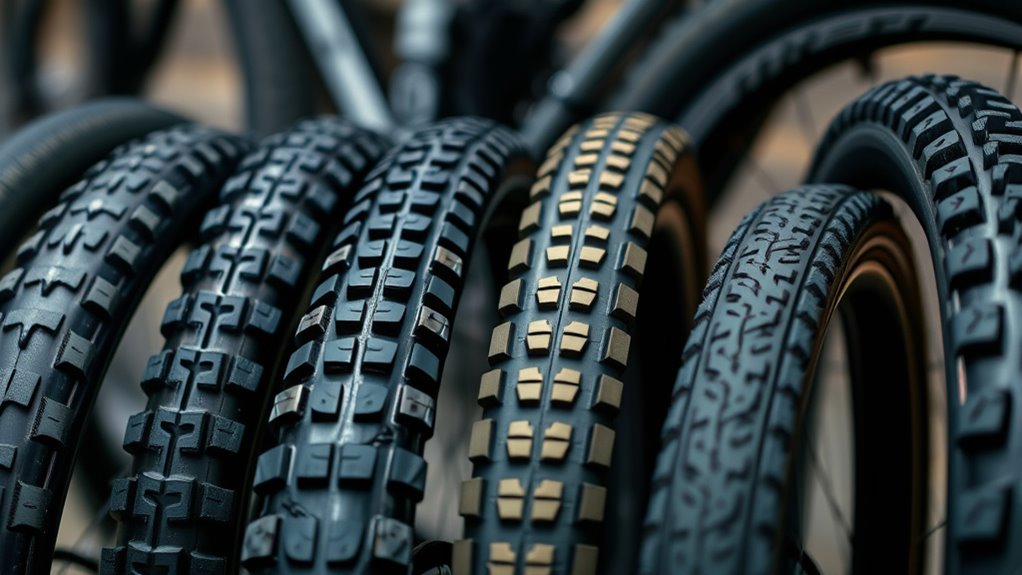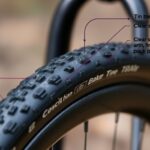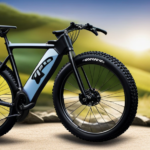This year, bike tires have seen exciting innovations, especially with tubeless technology for smoother rides and fewer flats. You’ll notice enhanced rubber compounds that improve grip in wet conditions and reduce rolling resistance. Advanced construction techniques, like wider rims, allow for lower pressures, boosting traction and comfort. Plus, companies are focusing more on sustainability in production. Keep an eye on these trends, as there’s plenty more to discover about the latest in bike tire advancements!
Key Takeaways
- Tubeless technology continues to rise, offering fewer flats and enhanced performance through lower tire pressures and improved traction.
- Advanced rubber compounds, including graphene and Kevlar microfibers, enhance grip in wet conditions and provide better puncture resistance.
- Wider rims are gaining popularity, allowing for increased tire volume, lower pressures, and improved comfort and traction on varied terrains.
- Innovative tread patterns evolve to optimize cornering, braking, and acceleration, with specialized designs reducing debris build-up for better performance.
- Sustainability in tire production is emphasized, with companies integrating recycled materials and eco-friendly practices to minimize environmental impact.
The Rise of Tubeless Technology
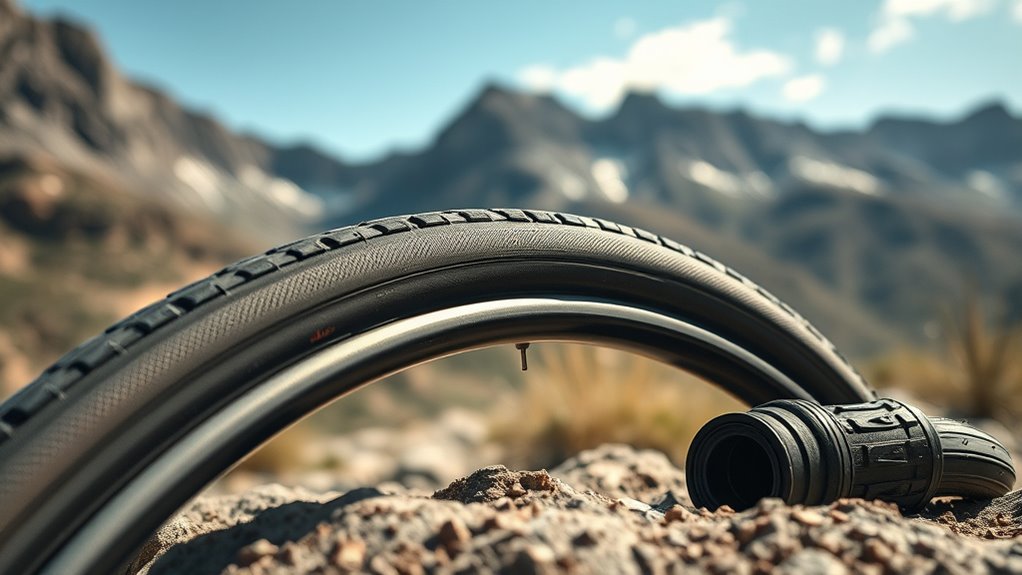
As you explore the evolution of bike tires, you’ll notice that the rise of tubeless technology has revolutionized the cycling experience.
Tubeless systems considerably reduce flats by eliminating the friction of traditional tubes, enhancing your safety and reliability, especially on poorly maintained roads. By allowing lower tire pressures, these systems improve traction and compliance, boosting overall performance during your rides.
Recent advancements in rim design have further enhanced aerodynamics and reduced rolling resistance, making each pedal stroke more efficient.
Recent rim design innovations boost aerodynamics and minimize rolling resistance, enhancing the efficiency of every pedal stroke.
Shifting to tubeless might require some adjustment as you adapt to lower pressures, but you’ll quickly appreciate the increased control and puncture resistance once you hit the trails.
Make sure your wheels and tires are compatible for peak performance. Additionally, consider the importance of risk-taking in adopting new technologies to maximize your cycling experience.
Innovations in Tire Design

In today’s bike tire market, innovations in design are transforming your riding experience.
With advanced rubber compounds like those from Vittoria and Goodyear, you’re getting better grip and efficiency than ever before.
Plus, the continued evolution of tubeless technology means you can enjoy a smoother ride with fewer flats.
Additionally, optimal tire pressure adjustments can significantly enhance traction and comfort on varied terrains.
Advanced Rubber Compounds
While many cyclists focus on tire tread patterns and sizes, the real game-changer in bike tire performance lies in advanced rubber compounds.
Brands like Vittoria are incorporating graphene to enhance grip in wet conditions while reducing rolling resistance. Goodyear’s Dynamic:GSR blend optimizes rolling efficiency, traction, and durability, showcasing a commitment to performance.
Pirelli’s integration of Kevlar microfibers greatly boosts puncture protection, demonstrating a shift towards advanced materials. Vittoria’s innovative 4C process layers four different rubber compounds in one tire, enhancing performance across varied conditions.
Maxxis also develops specialized formulations that maintain essential performance characteristics while optimizing durability and grip. These advancements in rubber technology are reshaping the cycling experience, making your ride safer and more efficient than ever. Additionally, the incorporation of high fiber content in some tire materials may help improve overall performance under varying conditions.
Tubeless Technology Enhancements
The advancements in rubber compounds have paved the way for innovative tire designs, particularly with tubeless technology. This cutting-edge design greatly reduces flat incidents, enhancing safety and reliability for cyclists.
Here’s what you can expect from this year’s tubeless tires:
- Liquid sealants that automatically seal punctures, perfect for long rides.
- Lower pressures that improve traction and control, especially for off-road adventures.
- Enhanced rim designs that accommodate wider tires for ideal performance.
With innovations like tire inserts, such as CushCore and Vittoria’s Air Liner, you can enjoy better ride quality while reducing pinch flats. Additionally, embracing tubeless technology allows for improved color accuracy in tire performance, ensuring a smoother ride on various terrains.
Embracing tubeless technology means you’re not just riding safer; you’re also revealing the potential for a more enjoyable cycling experience.
Enhanced Rubber Compounds
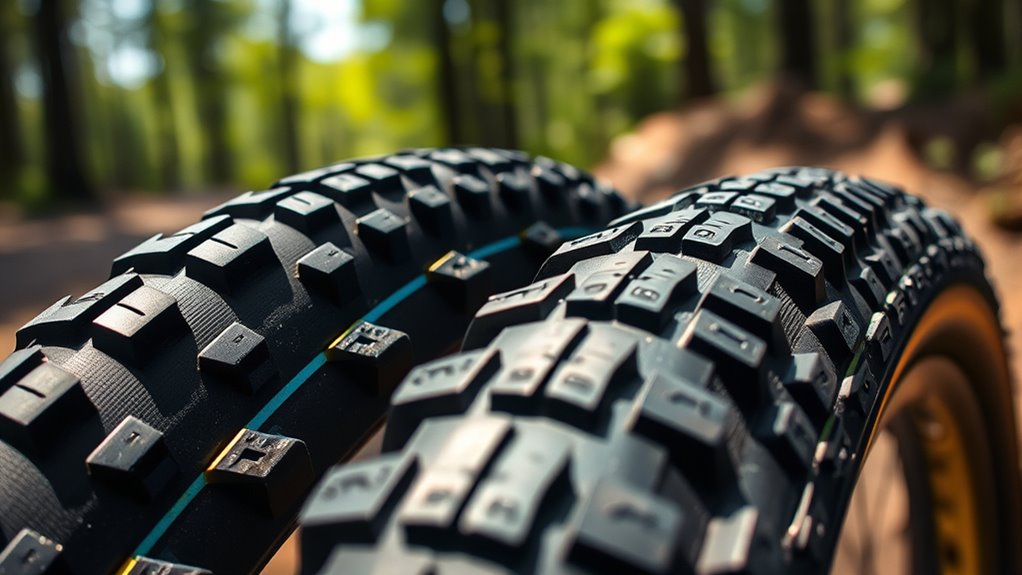
As you explore the latest bike tires, you’ll notice how advanced rubber compounds are transforming performance on the road and trails.
Manufacturers are strategically optimizing grip and durability, ensuring you get the most out of every ride.
With innovations like multi-compound designs, your tires can now adapt to various conditions, enhancing your cycling experience. This mirrors the way high-quality equipment in sound recording significantly impacts overall performance and quality.
Advanced Material Innovations
With advancements in rubber compound technology, bike tires have transformed remarkably, giving you better performance and safety on the road.
These innovations utilize advanced materials to enhance durability and ride quality, guaranteeing you enjoy every ride with confidence.
- Vittoria’s graphene integration improves wet weather grip and reduces rolling resistance.
- Maxxis’s 3C Triple Compound technology optimizes grip, rolling resistance, and durability for lasting performance.
- Schwalbe’s Aerothan tubes, made from Thermoplastic PolyUrethane (TPU), provide over 65% weight savings and outstanding puncture protection.
These cutting-edge solutions not only elevate your riding experience but also assure you can tackle challenging terrains without worry.
Embracing these advancements means you’re riding on the forefront of tire technology. Additionally, understanding performance tuning can lead to better overall cycling performance as well.
Performance Optimization Strategies
While many cyclists focus on tire tread patterns and pressure, optimizing performance through enhanced rubber compounds is equally essential. Innovations like Vittoria’s use of graphene greatly improve wet weather grip while reducing rolling resistance, a key factor in performance optimization strategies.
Goodyear’s Dynamic:GSR blend emphasizes rolling efficiency and traction, showcasing advancements in rubber formulations. Pirelli’s incorporation of Kevlar microfibers enhances puncture resistance, contributing to overall durability.
Additionally, Vittoria’s innovative 4C process layers four different compounds for tailored grip and efficiency. Maxxis’s 3C Triple Compound technology remains a benchmark, optimizing tire performance across grip and durability aspects. Furthermore, the latest developments in rubber formulations are pushing the boundaries of what cyclists can expect from their tires in terms of performance and safety.
Durability and Grip Enhancements
When you ride, having tires that balance durability and grip can greatly enhance your cycling experience. Recent innovations in rubber compounds deliver impressive results:
- Vittoria’s graphene-infused tires improve wet weather grip while cutting rolling resistance for better efficiency and durability.
- Maxxis’s 3C Triple Compound formulation optimizes grip and rolling resistance, guaranteeing consistent performance across various conditions.
- Schwalbe’s Aerothan tubes provide lightweight design with maximum puncture protection, boosting tire longevity.
These advancements in multi-compound technologies and advanced materials, like Pirelli’s Kevlar microfibers, guarantee that your tires not only withstand the rigors of the road but also enhance your ride with superior handling and traction. Creativity can be cultivated through these enhancements, leading to a more enjoyable and reliable cycling journey.
Advanced Construction Techniques
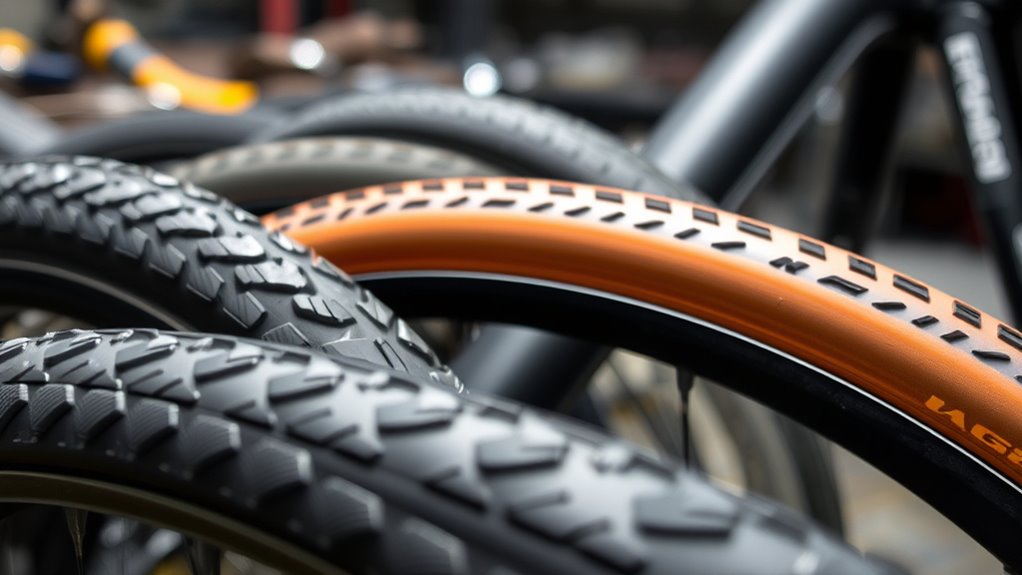
As bicycle technology evolves, advanced construction techniques are at the forefront, enhancing performance and safety.
You’ll notice that many new tires now feature bias-ply designs, boosting both durability and lightweight characteristics to meet your cycling needs. Advanced materials like Pirelli’s Kevlar microfibers notably improve puncture resistance while maintaining high performance standards.
Vittoria has taken it a step further by incorporating graphene, enhancing grip and rolling resistance without sacrificing durability. Tubeless technology minimizes pinch flats, allowing you to ride with lower tire pressures for better traction and comfort on rough terrain.
Additionally, multi-compound technologies, such as Vittoria’s 4C process, let you customize tire performance across various conditions, ensuring you get the most out of every ride. Moreover, incorporating natural materials in tire construction can enhance durability while promoting eco-friendly practices.
Tread Pattern Evolution
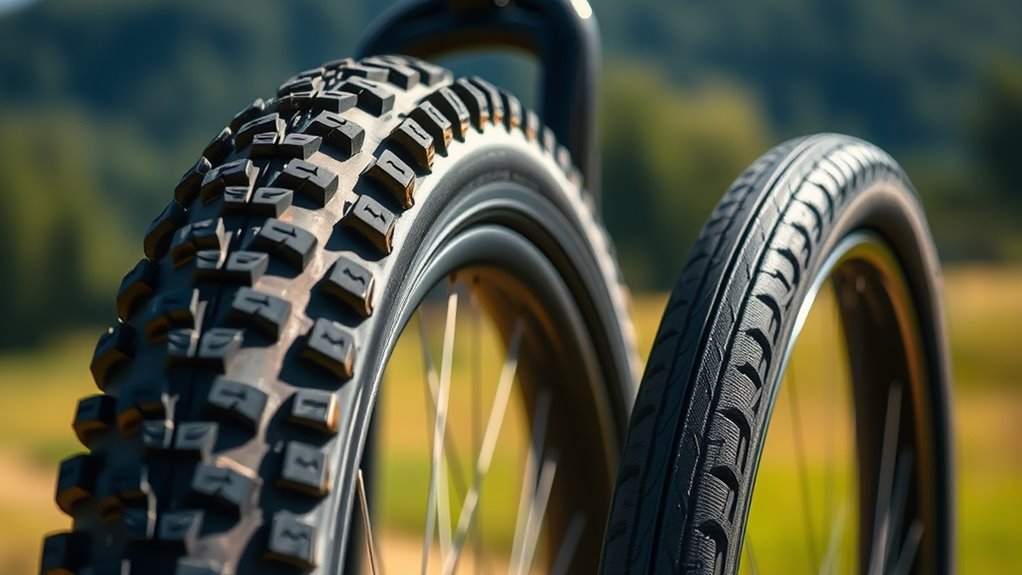
Tread patterns have dramatically evolved, driven by the need for enhanced performance in various cycling conditions.
Today’s mountain bike tires feature innovative designs that cater to specific needs, ensuring you get the best grip and stability.
Here are some key advancements:
- Nuanced Features: Modern patterns enhance cornering, braking, and acceleration.
- Debris Ejection Channels: These channels prevent mud and dirt build-up, improving traction on challenging trails.
- Specialized Designs: Innovations like Vittoria’s ramped fish scale pattern boost adaptability across diverse terrains.
The shift from traditional symmetrical designs to these specialized tread patterns reflects the industry’s commitment to optimizing tire performance for every ride, letting you tackle any trail with confidence. Additionally, similar to how Porsche tuning brands enhance vehicle performance, tire advancements focus on improving grip and stability for cyclists.
The Impact of Wider Rims
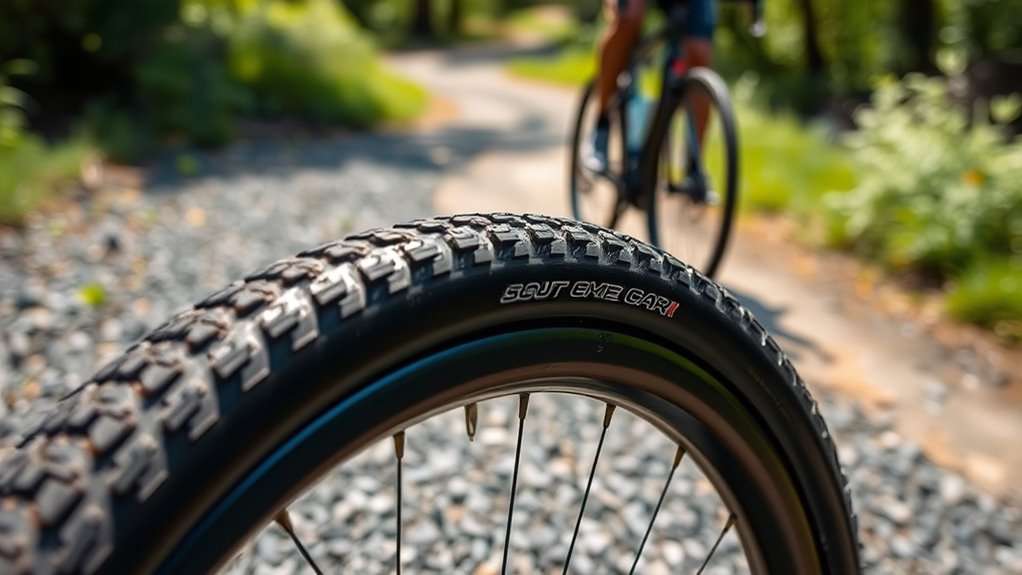
Wider rims can dramatically boost your bike’s performance by increasing tire volume, giving you better traction and comfort on different surfaces.
You’ll notice enhanced grip and stability, especially when riding on challenging terrains.
Plus, with the ability to run lower pressures, your ride becomes smoother without compromising safety.
Increased Tire Volume Benefits
Many cyclists have noticed the benefits of increased tire volume, especially when paired with wider rims. This combination not only enhances ride quality but also allows for lower pressure, making your rides smoother and more efficient.
Here are some key advantages:
- Better traction: Increased tire volume improves the contact patch with the ground, enhancing grip on various surfaces.
- Reduced pinch flats: With lower pressure, you decrease the chance of pinch flats, giving you more confidence on rough terrain.
- Lower rolling resistance: Wider rims and tires contribute to improved speed, making them ideal for competitive cycling scenarios.
Embracing wider rims means you’re not just upgrading your bike; you’re also enhancing your overall cycling experience.
Enhanced Grip and Stability
As you embrace wider rims, you’ll immediately notice how they enhance grip and stability on various terrains.
The increased tire volume allows for lower tire pressures, boosting traction and making your ride smoother. With wider rims, you can fit larger tires, which expands the contact patch with the ground, improving grip during cornering and braking.
Research shows that tires paired with these rims can see up to a 10% reduction in rolling resistance, making your ride more efficient. This shift has driven demand for tires that optimize performance, leading to innovations in tread patterns and rubber compounds.
Professional cyclists have found that wider rim setups enhance their confidence, especially at high speeds and on technical trails.
Benefits of Lower Pressures
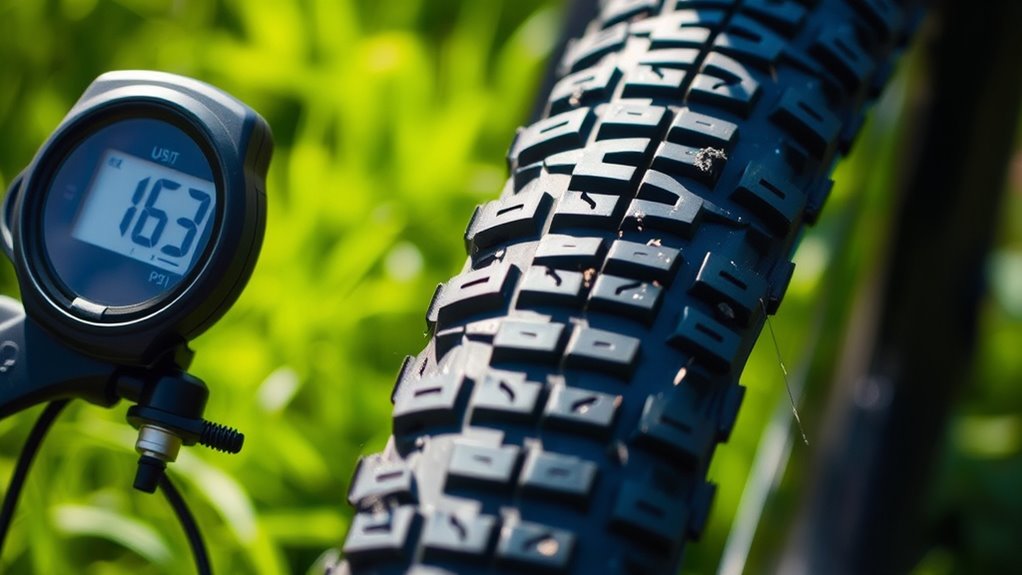
While you might think higher tire pressure is always better for performance, running your bike tires at lower pressures can actually offer significant advantages.
For MTB tires, lower pressures can enhance your riding experience in several ways:
- Improved traction and grip: Lower pressures increase tire contact with the ground, allowing for better control on varied terrains.
- Enhanced comfort: Riding at lower pressures helps absorb shocks from obstacles, reducing fatigue on rough surfaces.
- Safer pinch flat prevention: With ideal pressures around 20 psi, you get a balance of performance while minimizing the risk of pinch flats, especially with tubeless systems.
Performance Improvements in Mountain Biking
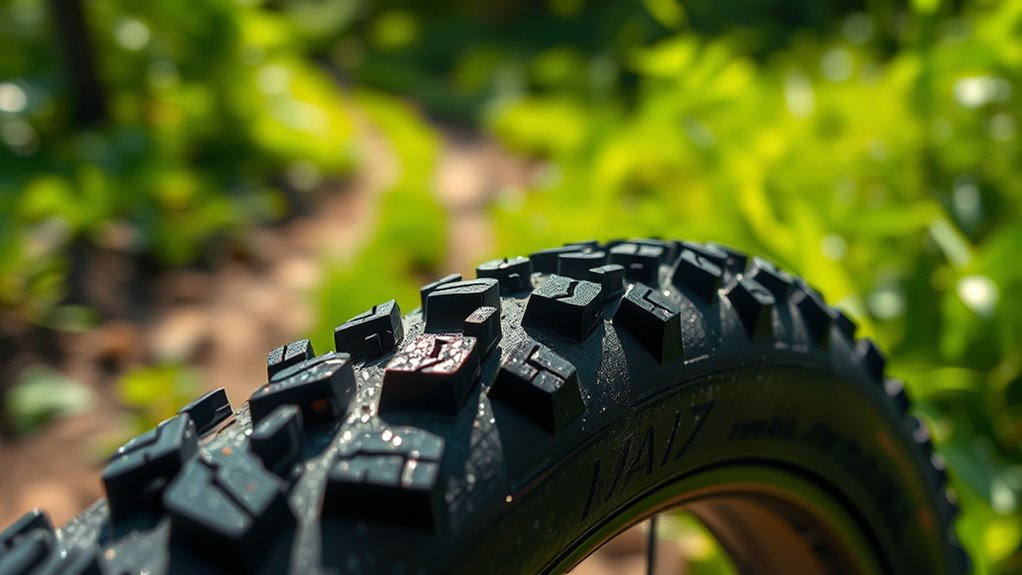
With the rapid evolution of mountain biking technology, riders are experiencing unprecedented performance improvements in their tires.
Today’s mountain bikes utilize advanced tread patterns that enhance grip during cornering, braking, and acceleration, moving away from older symmetrical designs.
Multi-compound technologies, like Vittoria’s 4C and Maxxis’s 3C, optimize performance across various conditions, balancing grip, rolling resistance, and durability.
Multi-compound technologies enhance tire performance, expertly balancing grip, rolling resistance, and durability for diverse riding conditions.
Innovations such as graphene-infused rubber compounds provide better wet weather grip and reduced rolling resistance, greatly boosting overall tire performance.
Tubeless technology reduces flat incidents, allowing you to run lower tire pressures for enhanced traction and terrain compliance.
New tire designs, like Schwalbe’s Eddy Current, prioritize puncture protection and durability, featuring larger knobs for superior performance on rugged trails.
Sustainability in Tire Production

Sustainability in tire production is becoming increasingly essential as the cycling industry seeks to minimize its environmental impact. Companies like Schwalbe are leading the charge with innovative practices that prioritize eco-friendliness.
Here are some key initiatives:
- Schwalbe’s recycling program has recycled over 1.1 million inner tubes, aiming for 14 million tires in five years.
- Their new manufacturing process utilizes recycled butyl rubber without sacrificing quality.
- The Airless System eliminates the need for pumping, promoting a maintenance-free, greener cycling experience.
Future Trends in Bicycle Tires
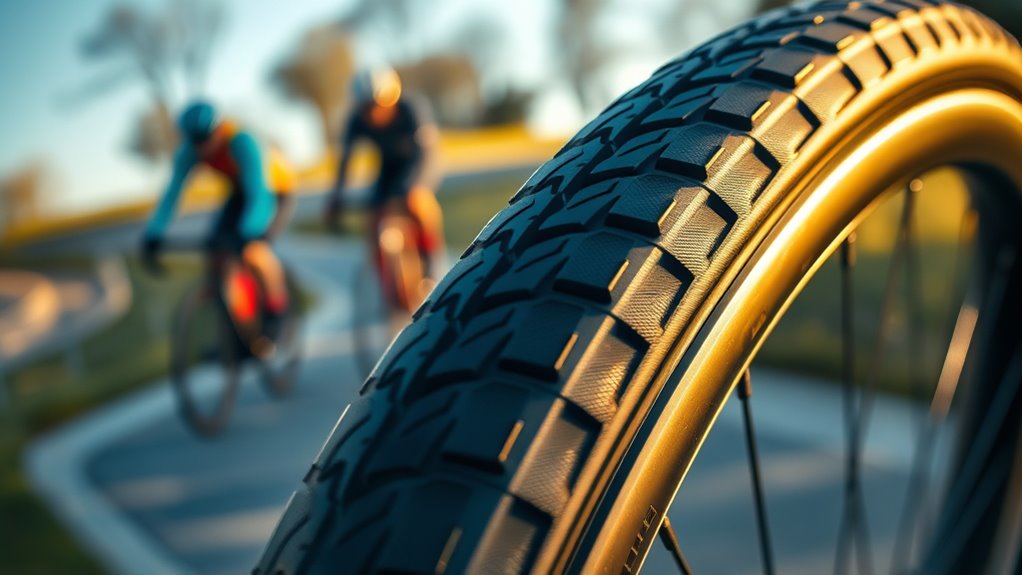
As the cycling world evolves, future trends in bicycle tires are set to revolutionize your riding experience.
The tire market is embracing tubeless technology, which minimizes flats and enhances ride quality with lower pressures and better puncture protection. Innovations like Vittoria’s 4C process are optimizing tire performance, allowing you to tackle various conditions with improved grip and durability.
The tire market is innovating with tubeless technology, enhancing ride quality and performance across diverse conditions.
Sustainable practices are gaining traction too, with companies integrating recycled materials into production and initiating recycling programs. Advanced materials, such as synthetic rubbers and graphene, promise enhanced grip in wet conditions and reduced rolling resistance.
Ongoing research into aerodynamics and tire-wheel coupling will drive future designs, ensuring they meet both professional racing demands and your everyday cycling needs.
Frequently Asked Questions
What Is the Evolution of Bike Tires?
Bike tires have evolved greatly over the years.
You’ll notice advancements like tubeless technology, which reduces flats and allows for lower pressures, enhancing traction.
Innovations in rubber compounds improve grip, especially in wet conditions, while sophisticated tread patterns optimize cornering and braking.
Lightweight constructions cater to different riding styles, and multi-compound technologies let you fine-tune performance based on terrain.
What Is the Downside of Tubeless Tires?
When it comes to tubeless tires, you might find yourself in a bit of a pickle. They can require a learning curve, as you’ll need to adjust to lower pressures that might feel unfamiliar.
If you don’t maintain them, the sealant can dry out, leading to reliability issues. Plus, installation and repairs can be tricky, especially if you’re not used to the system.
Compatibility is key; mismatched equipment can cause serious headaches.
Why Do Bikes Have Fat Tires Now?
Bikes have fat tires now because they offer better traction and stability across various terrains.
You’ll find them perfect for off-road, snow, or even sandy conditions. With their wider surface area, you can ride comfortably at lower air pressures, enhancing shock absorption on rough paths.
The rise in their popularity also aligns with cyclists seeking versatile options, especially as more people embrace recreational biking for fun and adventure during recent years.
What Is the Lifespan of a Bike Tire?
Imagine you’re cruising down a winding trail, the perfect bike tires beneath you.
Typically, bike tires last between 1,000 and 3,000 miles, but that can change based on your weight, terrain, and maintenance. If you ride on rough trails with low pressure, your tires might wear out faster.
Regularly inspecting for cracks or bald spots helps you decide when to replace them, ensuring your rides remain smooth and safe.
Conclusion
As you ride into the future, embrace the shift from traditional tubes to cutting-edge tubeless technology. Experience the balance of enhanced rubber compounds and advanced construction techniques, where innovation meets performance. Enjoy the benefits of lower pressures that boost traction while steering through evolving tread patterns. With a growing focus on sustainability in production, you’re not just riding; you’re contributing to a greener world. So gear up—this year’s tire advancements are paving the way for a thrilling cycling experience.
